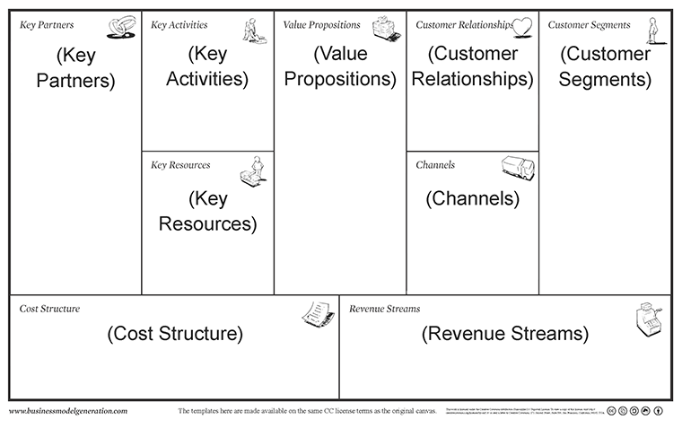Business Model Canvas
Alexander Osterwalder originated Business Model Canvas in his book Business Model Ontology. This bestselling book outlines nine components that are part of the business model in an easy-to-read one-page canvas.
You can use the business model canvas to conjecture your business model, your customer base, the value propositions you provide through what channels, and how your company makes money. You can also use it to analyze your business model or one of your competitors!
The picture below will outline the rationale of how an industry generates, addresses, and apprehends value.
Why is it a masterpiece for business sustainability?
- In a flash, it explains in detail what the idea has painted.
- Permits you to induce an understanding of your business.
- Allows going through a connection-making process between what your thought is and how to add it into a business.
- Analyzes how customer judgments affect the use of your services.
- By a model canvas, every stakeholder sees an unclouded picture of the business.
How these nine factors can generously let your business run smooth?
Key Partners
Key partners are the business industries that are associated with the business to execute operational tasks and deliver value to the customer. It is a list of suppliers, companies, or other parties who take an enterprise to a level it could not achieve individually. In simple words, without these entities, you are eligible to prosper in business to achieve impossible goals.
Key Partnership, this segment will let a business grow and exempts weak points. Helps to determine the activities and resources are aligned according to business strategy or not.
What’s lacking to perform operational duties? Can your partners do some of those?
Your key partners include investors, the advertisement mediums, regulators, third-party logistics (TPL), Amazon, Alibaba, or goods companies who sponsor you to sell their products. It is recommended that you map key activities to key partners. If a key activity is part of your business model, this is one way for you to determine which partners are handling the various Key activities.
Key Activities
These are the key responsibilities that the company distributes to its ventures for execution and run other business tasks smoothly. For instance, if marketing through 3rd party mediums is part of the model, then action around channel management is probably pretty relevant.
What you have to consider for achieving a value proposition?
- How does the business achieve the value proposition for the customer?
- What is the purpose of the resource?
- What expertise does 3rd party offering?
- How to ensure the distribution of products?
- How to achieve technical development?
- What are the strategies to satisfy consumers?
If your company is focused on building products, this will probably require learning about users as well as developing new techniques.
If your center is on catering various services for a specific set of customers like design, marketing, or writing industry, this probably includes;
- Content/services licensing
- Content/supply distributions
- Data/Market research and analytics
- Sales and marketing
- Consulting
- Designing
Key Resources
There are three main business types: product, scope, and infrastructure, all of which require similar Key Resources. The Business Model Canvas suggests that these core business types have similar types of Key Resources.
The Key Resources of a business should correlate with the key initiatives of the business. Next, you should think about what practical resources are needed to achieve the goals of the business?
This is what you need practically to execute your business activities:
- Office space
- Brands
- Hosting/Platforms
- Staff/Employees
- Production
- Online appearance
Value Propositions
- The requirements or problems that you identified about your business, are resolved or not?
- What makes you stand out among competitors or alternatives?
- What is the strategy of doing business?
- Why do the customers convert to other service providers, stores, or any other alternatives?
It is okay if you have many precautions, start by solving them step by step. Rank them according to the importance of the matter, you will win out the most hazardous.
For instance, an enterprise has joined us because of cost-saving offers and the best practices. When time flies, you realize that the strategies and all assumptions were wrong. Should have invest time and risk to provide new services, capture clients from the market, free offers, excellent customer service, and engaging customers was the most important operations to consider.
Customer Relationships
Now, you have already interacted with the segment of the value proposition which will help you to identify the techniques to build better relationships with customers.
Customer Relationship is defined as how a business engages and satisfies its customers. Create a map of your customers as to how they interact with your business through various mediums. You have to focus on;
- Ideal service protocols
- Fulfilling demands
- Ease of service
Channels
Channels are the pathways through which your customer interacts with your company and becomes part of your sales funnel. This is generally covered under the marketing plan for your business.
You can use channels to communicate your proposition to your segments, as well as sell products and later service customers (see AIDA OR journey below).
For example, if you are a lighthouse vendor and there is a website where all lighthouse attendants purchase equipment, that could be a Channel. Google AdWords could be a Channel as well (for getting attention).
Consider these channels to strategize your marketing plan.
- Social media
- Public speaking
- Electronic mail (email marketing)
- Networking
- SEM (Search Engine Marketing)
- SEO (Search Engine Optimisation)
- Engineering as marketing
- Viral marketing
- Targeting blogs
- Sales and promotions for commissions
- Affiliates
- Existing platforms
- PR
- Unconventional PR
- Social advertising
- Trade shows
- Content marketing
- Community building
- Offline advertising (billboards, TV, radio)
Customer Segments
Customer segmentation refers to the practice of grouping individuals according to shared characteristics, i.e., age, gender, interests, purchasing habits.
How to determine your customer segments?
- Who are we solving the problem for?
- Which people will appreciate my value proposition?
- Is this an entirely separate company?
- Do those companies have any special characteristics?
- Do they belong to another group?
Your business share and how many customers there in the customer segment are another thing to measure and consider. This will allow you to get a micro and macro view of the industry.
Cost Structure
You have been struggling to learn, how your main activities propel your proposals and hence your income. The monetary cost of working as a company is specified in your business costs system.
How are they expense driving?
Are costs faster or varying as various business models are testified? Are they more scalable or set for scaling?
Revenue Structure
Revenue streams are the way that the enterprise turns your value proposal or approach to the challenge of the consumer into a financial benefit.
Additionally, you have to think about the price you charge for your services and the expenses you incur to fix the client’s problem.
Custom logo design services is one of the best thing a business should invest to brand itself in the market.


